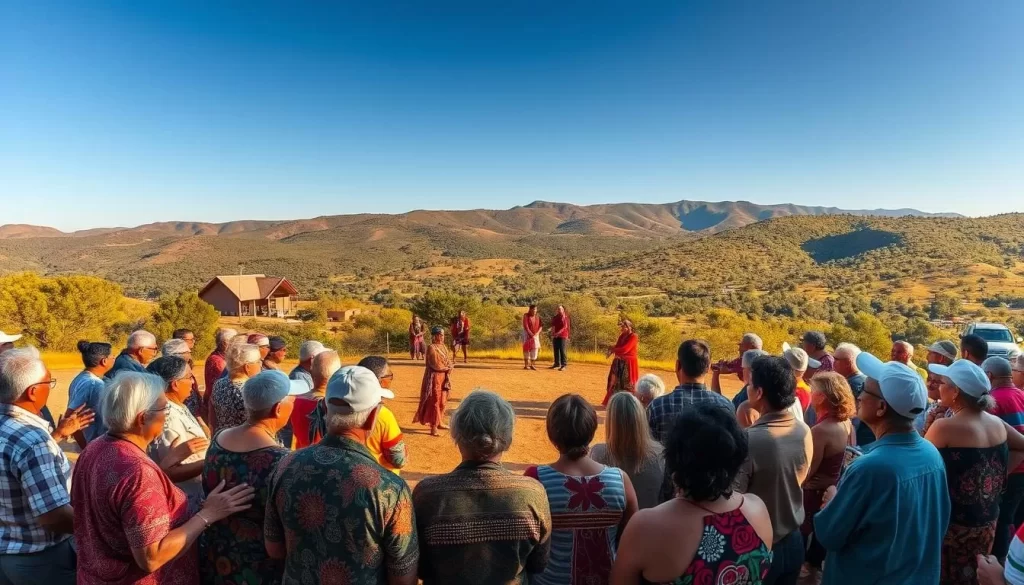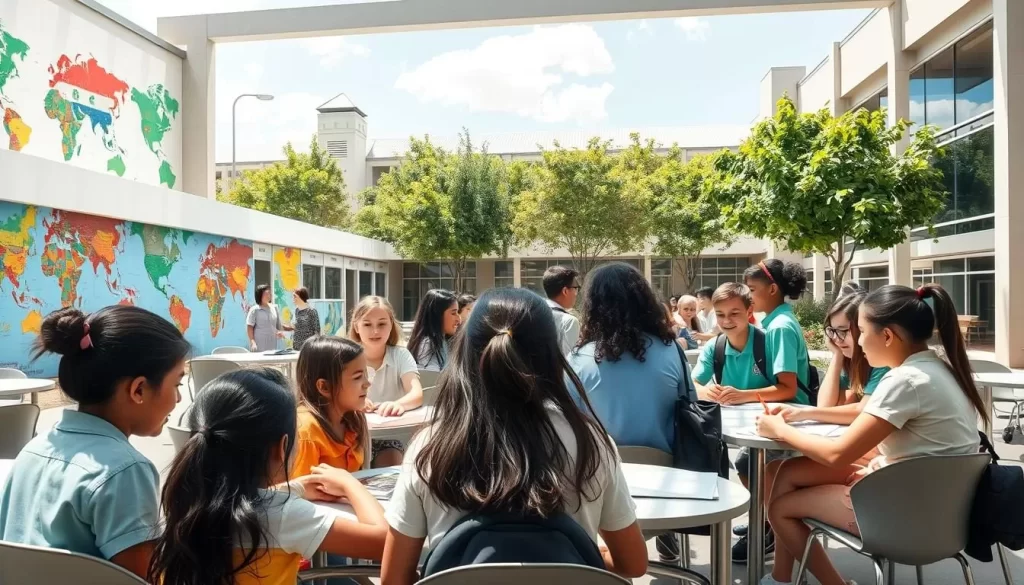✓ Accommodations✓ Flights✓ Rental Cars
When you think about the languages spoken in Western Australia, English is likely the first that comes to mind. While it’s not legally declared as the official language, it’s the most common language used by the majority of the population. In fact, 72% of people speak only English at home, according to the 2021 census.
But the linguistic landscape here is far more diverse. Over 120 to 170 indigenous languages and dialects are still spoken today, reflecting the rich cultural heritage of the area. These languages, alongside immigrant languages, add to the vibrant community of speakers.
Historical immigration trends have also shaped the language scene. From European countries to Asian nations, the influx of people has brought a variety of dialects and creoles into the mix. This diversity is a testament to the state’s evolving identity.
Join us as we explore this fascinating blend of languages, from historical roots to modern-day usage. You’ll discover how Western Australia’s linguistic diversity reflects its unique cultural tapestry.
Understanding Australia’s Linguistic Landscape
Australia’s linguistic landscape is a fascinating mix of history, culture, and diversity. From its indigenous roots to its modern multicultural identity, the story of language here is both rich and complex. Let’s dive into how this evolution unfolded and what it means today.
Historical Perspectives on Language in Australia
When British settlers arrived in 1788, they brought English with them. This marked the beginning of a significant shift in the linguistic landscape. Over time, English became the common language, even though it was never officially declared as such.
Before European contact, over 250 indigenous languages were spoken across the continent. These languages were deeply tied to the land and culture of Aboriginal and Torres Strait Islander communities. Sadly, many of these languages declined as English gained dominance.
Immigration also played a key role. Waves of settlers from European and Asian countries introduced new dialects and creoles. For example, Greek migration in the 1850s and Vietnamese migration in the 1970s added to the linguistic tapestry.

Current Trends and Census Insights
Today, over 300 languages are spoken across the country. English remains the first language for over 72% of the population, but other languages like Mandarin, Arabic, and Cantonese are also widely used.
The 2021 census reveals interesting shifts. While English is still the majority language, there’s a growing proportion of people speaking other languages at home. This reflects the increasing cultural diversity in the country.
Immigration continues to shape the linguistic scene. Humanitarian arrivals since 2000 have introduced over 200 languages, many of which are now part of the community.
As Australia evolves, so does its language landscape. Understanding this history and these trends helps us appreciate the vibrant diversity that defines the country today.
Western Australia, Australia: Official and widely spoken languages – A Closer Look
Exploring the languages of Western Australia reveals a rich tapestry of history and identity. This state is home to a unique blend of English dominance and indigenous language resilience. Let’s take a closer look at how these dynamics shape the linguistic landscape.
English and Indigenous Language Dynamics
English is the most common language spoken in Western Australia, with 75.3% of the population using it at home. This dominance reflects the historical influence of British settlement. However, the state also boasts a vibrant indigenous language scene.
Over 120 indigenous languages and dialects are still spoken today, showcasing the cultural heritage of Aboriginal communities. Languages like Kriol, a creole, bridge traditional and modern communication. This interplay highlights the resilience of indigenous cultures in the face of change.

Census Data and Community Proportions
The 2021 census provides valuable insights into language use. While English remains dominant, 23% of residents speak other languages at home. This includes immigrant languages like Mandarin, Arabic, and Vietnamese, which reflect the state’s multicultural identity.
Indigenous languages, though spoken by a smaller proportion, are a vital part of the community. Approximately 13% of Aboriginal and Torres Strait Islander people in the state speak their traditional languages. This number underscores the importance of preserving these dialects for future generations.
| Language | Speakers |
|---|---|
| English | 75.3% |
| Mandarin | 4% |
| Indigenous Languages | 13% (Aboriginal and Torres Strait Islander population) |
Demographic shifts are also influencing language dynamics. As immigration patterns evolve, the linguistic landscape continues to diversify. This trend is a testament to the state’s ability to embrace change while honoring its roots.
Diversity in Aboriginal, Torres Strait, and Community Languages
The linguistic diversity of Australia’s indigenous communities is a testament to its rich cultural heritage. From ancient dialects to modern creoles, these languages reflect the deep connection between language, culture, and identity.
Aboriginal and Torres Strait Islander Languages Overview
Before European contact, over 250 distinct indigenous languages were spoken across the country. Today, approximately 167 of these languages are still in use, with many being revitalized through community efforts. These languages are not just a means of communication but a vital part of cultural identity.
Creoles like Kriol and Torres Strait Creole, or Yumplatok, play a significant role in maintaining this identity. Yumplatok, for example, is spoken by over 7,000 people and serves as a bridge between traditional and modern communication.

Efforts to preserve these languages are ongoing. For instance, the Gumbaynggirr Giingana Freedom School, the first Indigenous bilingual school in NSW, opened in 2022 to teach students in their native language. Such initiatives highlight the importance of language in cultural continuity.
Impact of Immigration on Language Diversity
Immigration has significantly expanded Australia’s linguistic tapestry. Over 270 languages and dialects are spoken today, reflecting the community’s multicultural identity. Languages like Mandarin, Italian, and Greek are now part of everyday life in many areas.
According to the census, 15% of the population speaks a language other than English at home. This number has grown over the years, showcasing the influence of immigration on the linguistic landscape.
For example, in Greater Perth, 35% of residents were born overseas, bringing with them a variety of languages and dialects. This diversity enriches the community and highlights the importance of embracing both heritage and immigrant languages.
To learn more about the rich diversity of Aboriginal and Torres Strait Islander languages, visit our resources. For insights into the cultural identity of Indigenous Australians, explore this link.
Language Education and Policy Impact
Language education plays a pivotal role in shaping cultural identity and community cohesion. In Australia, government initiatives and educational strategies work together to preserve indigenous languages while supporting English as the primary language. Let’s explore how these efforts are making a difference.
Government Initiatives and Language Programs
The government has committed significant funding to support language education. For example, $14.1 million has been allocated to primary school programs focused on teaching First Nations languages. This investment helps keep endangered languages alive and strengthens cultural ties.
Indigenous Language Centres are another key initiative. These centers provide resources and support for communities to revitalize their native dialects. Programs like bilingual education also play a crucial role in balancing English proficiency with cultural preservation.

Educational Approaches to Language Preservation
Schools are at the forefront of language preservation. Many institutions now offer bilingual programs that teach both English and indigenous languages. This approach not only enhances language skills but also fosters a deeper understanding of cultural heritage.
According to the 2021 census, 22.3% of the population speaks a community language at home. This number has grown by 7.2% since 2001, reflecting the success of these educational efforts.
- Bilingual education programs bridge traditional and modern communication.
- Government funding supports the development of language resources.
- Community initiatives encourage the use of indigenous languages in daily life.
For more insights into language education policies, explore this detailed report. To understand the historical context of language policy, visit this resource.
Effective language policies benefit both students and the broader community. By preserving indigenous languages and supporting English education, Australia continues to build a diverse and inclusive society.
Conclusion
Australia’s language diversity is a reflection of its rich history and cultural evolution. English remains the most common language, spoken by 72.7% of the population at home, according to the 2021 census. However, the country’s linguistic tapestry is far more intricate, with over 300 languages in use.
Indigenous languages, though spoken by a smaller number of persons, hold deep cultural significance. Efforts to preserve these dialects are ongoing, ensuring they remain a vital part of the country’s identity. Additionally, immigrant languages like Mandarin, Arabic, and Vietnamese continue to thrive, enriching the community.
Education and policy play crucial roles in supporting this diversity. Programs aimed at teaching both English and indigenous languages help bridge the gap between tradition and modernity. This balance ensures that the country’s linguistic heritage is preserved while embracing its multicultural future.
To explore more about Australia’s language landscape, visit this detailed resource. Understanding this dynamic mix of languages offers a deeper appreciation of the cultural richness that defines the nation.
The above is subject to change.
Check back often to TRAVEL.COM for the latest travel tips and deals.






